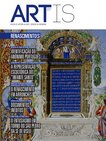 |
António João Cruz, Maria Teresa Desterro, Erica Eires, Sónia
Costa, Carla Rego, "Ser ou não ser Metsys: o desenho
subjacente do Tríptico da Vida de Cristo, de Tomar, e a sua atribuição
autoral", Artis, 5, 2017, pp. 104-113 |
|
⯇ | ⯈ |
| Resumo |
A caracterização do desenho subjacente das cinco pinturas do Tríptico da Vida de Cristo, da igreja de São João Baptista, em Tomar, é feita com base nas reflectografias de infravermelho, integrais e de elevada resolução, obtidas. Considerando as hipóteses de atribuição de autoria formuladas até à data, é efectuada a comparação do relativamente extenso desenho observado com o que, de acordo com a literatura, é característico das obras de Quentin Metsys, sua oficina ou seu discípulo Eduardo, o Português. Dos três tipos de desenho detectado, eventualmente correspondente a três mãos, o principal não encontra paralelo nas obras tomadas como referência, por ser significativamente "Mais" visível, "Mais" rigoroso e "Mais" detalhado. Porém, os outros dois tipos de desenho, usados de forma "Mais" localizada, têm algumas semelhanças com o observado em obras de Metsys. Estes resultados são discutidos no contexto das práticas oficinais da época e do problema de autoria colocado pelo Tríptico. |
| Title |
To be or not to be Metsys: the underdrawing of the Triptych of the Life of Christ from Tomar, and its authorship attribution |
| Abstract |
The characterization of the underdrawing of the five paintings that constitute the Triptych of the Life of Christ, belonging to the church of St. John the Baptist, in Tomar, Portugal, is done on the base of the high resolution and integral infrared reflectographs obtained. Considering the hypotheses of authorship formulated untill now, a comparison of the extensive underdrawing is made with the characteristics of the works of Quentin Metsys, his workshop or his disciple Eduardo, the Portuguese. They were detected three types of drawing, possibly corresponding to three different hands but the main one has not parallel with the works taken as reference, from the literature, because it is much more visible, more rigorous and more detailed. However, the other two types of drawings, used more locally, have some similarities to those seen in Metsys' works. These results are discussed in the context of the workshop practices of the sixteen century and the authorship problem posed by the Triptych. |
| Ver |
PDF |
| |
Academia | Researchgate |
| Importar |
RIS | Endnote |
